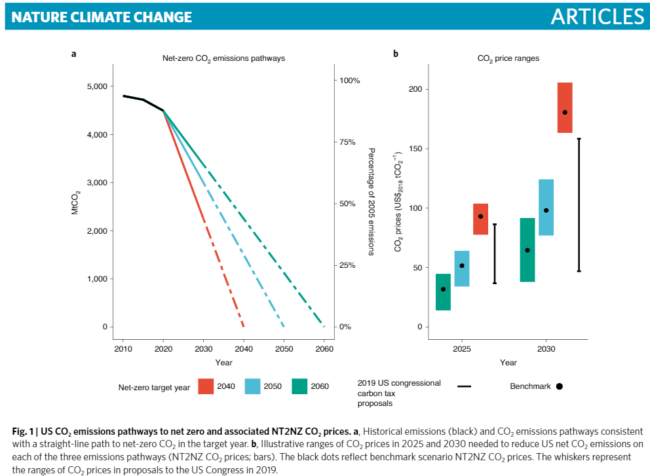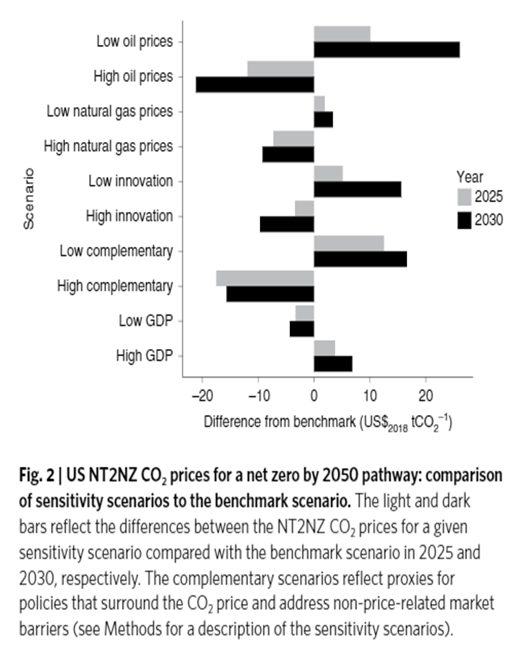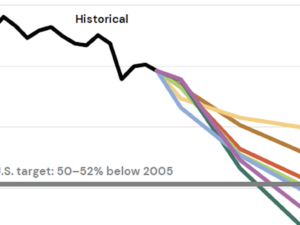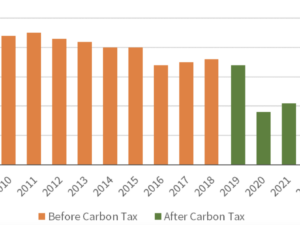New research says: Set an emissions goal. Get there with a carbon price.
By Jerry Hinkle
Important new research has just come out showing what carbon prices are needed to drive U.S. carbon emissions down to net zero by mid-century. This Columbia study was published in a top journal and looked at target years of 2040, 2050 or 2060. Though it is only from one model, it is important for our advocacy because the U.S. price path required to achieve net-zero by 2050 aligns perfectly with the Energy Innovation Act’s base price path, which starts at $15/ton and increases $10/ton each year thereafter. In addition, the paper discusses and quantifies the key sources of uncertainty in these estimates, providing climate advocates with a clear understanding of the key factors that would cause emission reductions to be more or less than estimated.
The paper begins by suggesting a U.S. carbon price path might best be established by having policymakers first set the emissions objective they want to achieve, then climate economists could estimate what price path would likely achieve that objective. The paper then presents results from three potential emission objectives: net-zero CO2 emissions by 2040, 2050 or 2060 (see left panel of chart, below). The range of U.S. carbon prices estimated to achieve each objective are shown at two points in time: 2025 and 2030 (right panel). Prices after 2030 would be determined at a later date with the benefit of having seen the emission reductions generated from the carbon prices up to that point.
The target year of most interest to CCL is 2050, as the Energy Innovation Act (1) and other important climate policy proposals state emissions targets anchored to this year. The estimated price range required to meet the net-zero 2050 objective is $34 to $64/ton in 2025 and $77 to $124/ton in 2030 (see blue bar in the graph). If the Energy Innovation Act carbon price began in 2021, it would reach $55/ton in 2025 and $105/ton in 2030, and these are right in the middle of the range of necessary prices. According to this very credible estimate, the Energy Innovation Act’s baseline carbon price path is well designed to achieve our science-based emission reduction target.
The article then discusses and quantifies the key sources of uncertainty in the modeling process that determine where, within the estimated range, the actual carbon price will need to fall to meet the objective. In other words, they give us an idea of where the model is most likely to be wrong, and by how much (see graphic below). Three sources warrant discussion. First, the model must assume what oil, natural gas and other energy prices will be going forward (assuming no carbon price). If the model is wrong, and oil prices are lower than expected, baseline emissions will be higher, and the carbon price will need to be about $25 higher in 2030 (top black horizontal bar in the graph, below) to achieve the net-zero by 2050 objective. In contrast, higher-than-expected oil and gas prices will mean the carbon price can be about $20 lower (second black bar).
A real wildcard is the level of innovation. A leading study (see page 9) on U.S. carbon tax modeling makes clear that “a carbon tax may spur innovation by increasing incentives for research and development on low-carbon or energy-efficient technologies relative to the reference case. Indeed, that may be one of its most important outcomes.” Modelers generally expect this effect to yield greater emission reductions than estimated by the model, and if this transpires, the carbon price can be lower.
Finally, a level of policies that complement emission reductions, such as “air quality regulations that lead to higher coal retirements, more aggressive energy efficiency measures and more aggressive early-stage deployment support for certain low-carbon technologies” (page 3 of the paper), are assumed in the model. If they are strengthened, the carbon price may be $10-$20 lower, and if they are weakened, $10-$20 higher.
These important results are very supportive of CCL’s advocacy and useful for our volunteers! They show that the Energy Innovation Act is well-designed to achieve the science-based reduction targets we are committed to. They also make clear that there is uncertainty in the estimates, what its primary sources are, and how material each is. This is a powerful study in support of strong climate action: run with it, advocates!
Footnotes:
- The Energy Innovation Act mandates 90% reductions of all net greenhouse gas emissions by that time (i.e., Methane, NOx, and others). Achieving net-zero CO2 emissions would mean slightly exceeding the bill’s target. Specifically, based on the bill’s reference year of 2015, achieving net-zero CO2 emissions, a reduction of 5411 MMT, would exceed our target of 90% of total net greenhouse gas emissions or 5244 MMT (90% of 5827).
Jerry Hinkle is a research coordinator for CCL.








